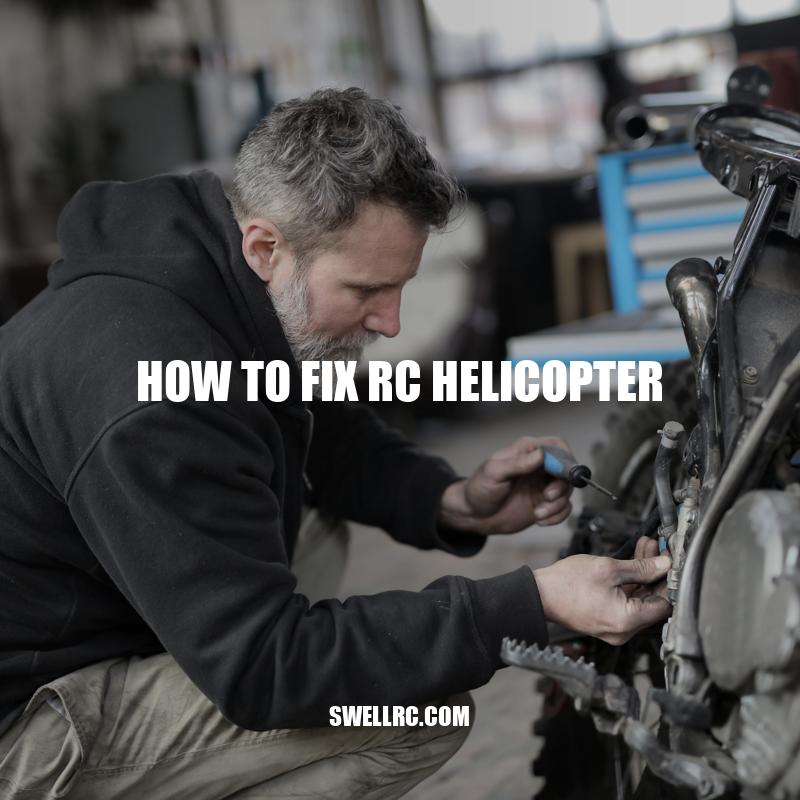Fixing RC Helicopter: A Guide to Troubleshooting Common Issues
Remote control (RC) helicopters are an enjoyable hobby, but they can be frustrating when they don’t operate correctly. Whether you are new to flying RC helicopters or a seasoned pilot, encountering problems from time to time is unavoidable. The good news is that most problems can be fixed without any professional help. Knowing how to identify and fix the issue will save you time and money in the long run. In this guide, we’ll discuss some common issues with RC helicopters and how to fix them. From low power and engine issues to remote connectivity problems, we’ll cover it all. By the end of this article, you’ll be equipped with the necessary knowledge and skills to troubleshoot and fix any RC helicopter issue that comes your way. So, strap in, and let’s get started on this exciting journey of fixing RC helicopters.
Identifying the Problem
Before we dive into fixing the issue, it’s essential to identify the problem that your RC helicopter is facing. RC helicopters are complex, and various things could go wrong, so identifying the root cause is necessary for quick and effective troubleshooting. Here are some common problems that RC helicopters face:
- Low power and battery issues
- Engine problems
- Broken blades or rotor assembly
- Remote connectivity issues
- Gyroscope or accelerometer problems
To identify the problem, inspect your RC helicopter carefully. Check for any damages or wear and tear, and examine the battery and connections. Try to fly the helicopter and observe the behavior. If the issue is not apparent, you can reach out to online forums or RC helicopter communities for help. Websites like RCGroups.com or HeliFreak.com have communities that discuss common issues and can provide valuable assistance. In the next section, we’ll discuss how to fix some of the common issues that RC helicopters face.
Why is my RC helicopter shaking?
There can be several reasons why an RC helicopter is shaking during operation. Here are some possible causes:
- Unbalanced rotor blades
- Loose screws, nuts, or bolts
- Damaged or misaligned rotor blades
- Dirty or damaged bearings
- Worn out motor or gears
- Radio interference
If the problem persists, it’s recommended to consult the user manual or contact the manufacturer for troubleshooting steps or repair services.
Note: Check out website(s) like HeliPal or products like Blade Inductrix FPV for more RC helicopter-related information.
Low Power and Battery Issues
One of the most common issues that RC helicopters face is low power or battery problems. Here are some troubleshooting steps to fix the issue:
| Issue | Solution |
|---|---|
| Dirty battery terminals | Clean the battery terminals with a soft cloth |
| Dead battery | Replace the battery with a new one |
| Broken or damaged wires | Replace the wires or fix them using insulation tape |
Interesting Fact:
Did you know that some RC helicopters require special batteries that are not easily available in stores or online? Make sure to check the battery requirement and buy them from authorized dealers.
If you are unable to fix the issue, there may be a problem with the motor or the electronics inside the helicopter. Reach out to the manufacturer or online communities for further assistance. Some websites like HorizonHobby.com offer a range of RC helicopter batteries and parts to replace damaged parts.
Why is my RC helicopter not flying high?
Here are some possible reasons why your RC helicopter is not flying as high as it should:
- The battery might be low or not properly charged.
- The blades may be damaged or not properly aligned.
- The weight of the helicopter may be too heavy for the motor to lift it high.
- The wind speed may be too high or the environment may be too humid.
- The controller may not be calibrated properly.
To troubleshoot the issue, try the following steps:
- Make sure the battery is fully charged and that it’s the correct one for your helicopter model.
- Inspect the blades for any damage or misalignment and adjust them accordingly.
- Remove any extra weight or upgrade to a stronger motor.
- Wait for a calmer day or find a more suitable location to fly your helicopter.
- Re-calibrate the controller according to the manufacturer’s instructions.
If the problem persists, it may be helpful to consult the manufacturer’s website for further troubleshooting tips or to consider purchasing a new helicopter altogether.
Engine Issues
Engine problems can be common in RC helicopters, especially if they are not maintained properly. Here are some tips to fix engine issues:
| Issue | Solution |
|---|---|
| Air filter clogged | Clean or replace the air filter |
| Carburetor dirty | Use a carburetor cleaner to clean the carburetor |
| Burnt spark plug | Replace the spark plug with a new one |
Always make sure to follow the user manual carefully when trying to fix engine issues. Damaging the engine while fixing it can make the problem worse. Sometimes the engine problem may be severe, and it may require the intervention of a professional mechanic.
To prevent engine issues, make sure that you are using high-quality fuel and lubricants that are recommended by the manufacturer. Websites like NitroRCX.com offer a range of engine parts and accessories to replace damaged parts. It’s always better to stock up on some spare parts to ensure that you are prepared for unexpected situations.
Why is my RC helicopter not lifting?
There are several reasons why your RC helicopter may not be lifting. Here are some possible reasons:
- The batteries may be dead or low in charge.
- The helicopter may not be properly balanced and trimmed.
- The rotor blades may not be spinning fast enough.
- The motor or gears may be damaged.
- The helicopter may be too heavy to lift.
If you need help troubleshooting your RC helicopter or need to purchase replacement parts, check out websites like HobbyKing, Horizon Hobby, or Amazon.
Blade Replacement
Another common issue with RC helicopters is damaged or worn-out blades. The blades are an essential component of any helicopter, and if they are not in good condition, they can cause accidents or further damage to the helicopter. Here’s what you should do if you need to replace RC helicopter blades:
| Step | Action |
|---|---|
| Step 1 | Remove the rotor head assembly |
| Step 2 | Remove the old blades by loosening the screws |
| Step 3 | Install the new blades and ensure that they are aligned correctly |
| Step 4 | Secure the blades with screws |
| Step 5 | Test the helicopter before flying to ensure that the new blades are working correctly |
Always make sure that you are using the right size and type of blades recommended by the manufacturer. You can find RC helicopter blades, along with other essential parts, on websites like Amazon and HobbyKing.
In addition to replacing the blades, it’s also crucial to balance them correctly. Unbalanced blades can cause the helicopter to vibrate and can even lead to more severe issues. You can balance the blades by using a blade balancer, which can also be found on these websites.
What happens if a helicopter loses a blade?
Losing a blade in a helicopter can be catastrophic and may lead to a crash. Helicopters are designed to continue flying safely with one failed engine or transmission, but losing a blade can cause immediate imbalance, making it almost impossible to control the helicopter. The severity of the situation depends on the altitude and airspeed at which the accident occurs.
If you want to learn more about helicopter operations or are interested in becoming a pilot, you can visit websites like rotor.org or myflightcoach.com. These websites provide detailed information about helicopter maintenance, safety measures, and training programs.
Issues with the Remote
If your RC helicopter is not responding to your remote, you may be facing a connectivity issue between the two devices. Here’s what you should do if you encounter this problem:
Battery Check
The first thing to check is the batteries in the remote as the low batteries can cause connectivity issues. Make sure to replace them with fresh ones and try again.
Rebinding the Remote
If the batteries are not the issue, rebinding the remote to the helicopter can help resolve connectivity problems. This process varies depending on the brand and model of your helicopter, so be sure to check the user manual first.
Remote Issues
Sometimes, connectivity issues can stem from problems with the remote. Check the antenna of the remote and ensure that it is attached correctly. If it is broken, replace it with a new one.
You should also check the buttons on the remote and cables that connect them to ensure that they are in good condition. If they are not working, you may need to replace them.
If you face any other issues with your remote or helicopter, you can get help from many online communities like RC Groups and RC Universe, where you can find a wealth of information and advice on fixing common RC helicopter issues.
Why is my remote control helicopter not lifting?
There may be several reasons why your remote control helicopter is not lifting, including:
- The helicopter battery may be dead or not fully charged
- The blades may not be attached or balanced properly
- The helicopter may be too heavy for the motor to lift
- The remote control may not be synced with the helicopter properly
If you are unsure of how to troubleshoot these issues, consult the manual that came with your helicopter or contact the manufacturer for assistance. Additionally, some remote control helicopter hobbyist websites may have forums or FAQs that address common issues.
Conclusion
In conclusion, RC helicopters are a great source of entertainment for both kids and adults. However, if your helicopter experiences any problems, it’s important to identify the issue and fix it promptly. We’ve covered some common problems and their possible solutions in this article.
Remember, always read the user manual to understand how your helicopter works and perform routine maintenance to keep it in good condition. Also, ensure that you follow safety procedures when handling the helicopter to prevent injury.
If you encounter any issue that is too complex or difficult to fix on your own, seek the help of professional technicians or manufacturers.
By maintaining your helicopter properly and identifying the problems early on, you will have many hours of stress-free and enjoyable flights. So, don’t hesitate to take care of your RC helicopter so it can remain in top-notch condition for as long as possible.



